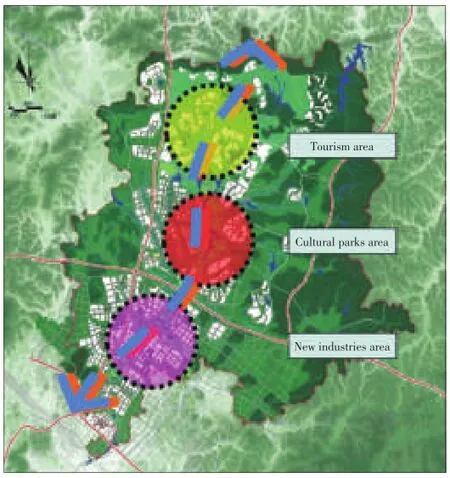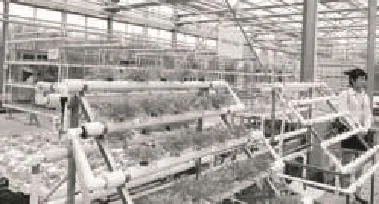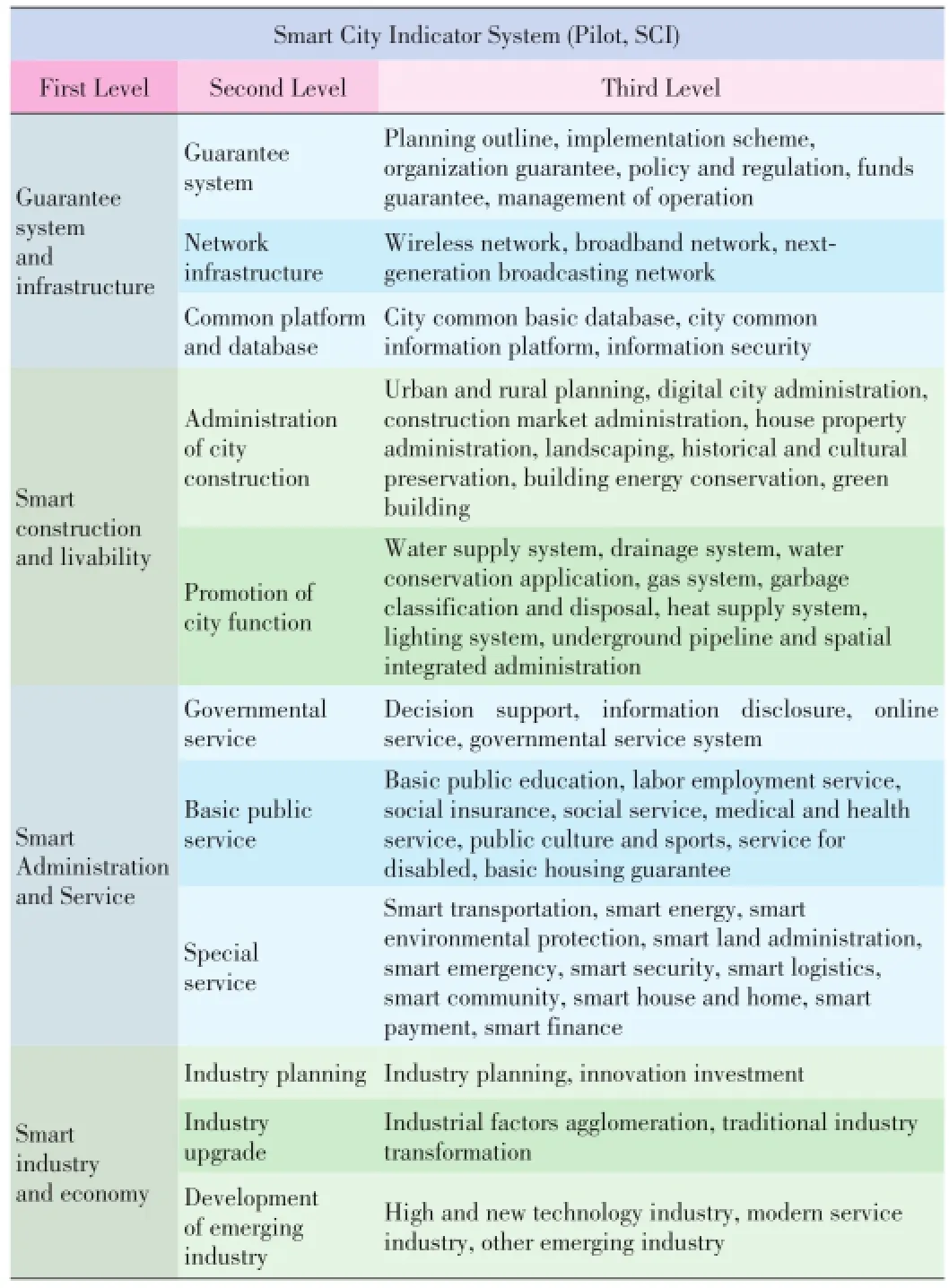Smart City Development in China:One City One Policy
Biyu Wan,Rong Ma,Weiru Zhou,and Guoqiang Zhang
(1.National Smart City Joint Lab,CSUS,MOHURD,Beijing 100835 China;2.iSoftStone Information Technology(Group)Co.,Ltd,Beijing 100193,China)
Smart City Development in China:One City One Policy
S
Biyu Wan1,Rong Ma2,Weiru Zhou1,and Guoqiang Zhang1
(1.National Smart City Joint Lab,CSUS,MOHURD,Beijing 100835 China;2.iSoftStone Information Technology(Group)Co.,Ltd,Beijing 100193,China)
China is in a process of urbanization and is aiming at a type of people⁃centered urbanization.The main purpose of developing a“smart city”is to help this type urbanization and to serve the people of the city.From 2012 to 2015,China has chosen more than 300 cities or towns to be national pilot“smart cities.”These pilot smart cities are located in more than 30 provinces around Chi⁃na,which differ greatly in thousands ways.So we advocated“One City One Policy”.In 2012,MOHURD announced 90 cities as first batch of pilot smart cities.After three years,some pilot cities achieved great progress.This paper introduces five example cit⁃ies(including town,district)as five different models of China’s smart city development.They are:Guilin city;Yunlong demonstra⁃tion zone;Panyu District;Yangling Agricultural Hi⁃tech Industries Demonstration Zone;Lecong town.This paper also introduces our standardization work on smart city field at present.
urbanization;MOHURD;pilot smart city;smart tourism;smart city indicator system
1 Introduction
C hina’s smart city development officially started in 2012,when the Ministry of Housing and Urban⁃Rural Development(MOHURD)announced 90 cit⁃ies or towns to be the first batch of pilot smart cit⁃ies.In April 2015,MOHURD announced the third batch.Now,MOHURD and the Ministry of Science and Technology are pro⁃moting the smart city pilots to work together,and in total,the number of three batch of national“pilot smart city”reaches 300.[1]
The overall idea of the national smart city pilot project is to start with solving the actual problems of a city or town through the comprehensive application of modern science and technolo⁃gy in order to add smartness to a city.The purpose of smart city development includes:urban planning and management of cities/towns/districts,the allocation of urban resources,creat⁃ing liveable environment,and using cultural heritage and inno⁃vation.In other words,the development of smart cities aims to promote the happiness of citizens and focus on urban sustain⁃able development.
Therefore,in the process of development of smart city,MO⁃HURD asks all pilot cities and towns to insist on an issue⁃ori⁃ented,demand⁃oriented and goal⁃oriented approach.This means one city has to work out a comprehensive plan and fol⁃low five guide points from MOHURD.The guides are focusing on:“one city one policy,people⁃centered strategy,city⁃indus⁃try integration,urban⁃management system innovation;market⁃ leading and optimizing resource allocation.
2 Five Pilot Smart Cities in China
After three years of development on smart city practice,some good results have been presented.Here,cases of five cit⁃ies(towns)are introduced as models of China’s smart city de⁃velopment.They are Guilin City,Yunlong Demonstration Zone,Panyu District,Yangling Agricultural Hi⁃Tech Indus⁃tries Demonstration Zone,and Lecong Town.
2.1 Smart Tourism in Guilin
Guilin is a prefecture⁃level city in the northeast of the Guangxi Zhuang Autonomous Region,China.It is situated on the west bank of the Li River,bordering Hunan to the north. The name Guilin means“Forest of Sweet Osmanthus,”owing to the large number of fragrant Sweet Osmanthus trees located in the city.The city has long been renowned for its karst moun⁃tains and is one of China’s most popular tourist destinations. At the end of 2014,Guilin city’s permanent resident popula⁃tion was 4.91 million—2.24 million urban population and 2.67 million rural population.Guilin’s urbanization rate is 45.6%. The natural population growth rate is 6.34%.[2]
Guilin as an international famous tourist city is chosen by the State Council of China as one state⁃level tourism reform pi⁃lot area.In November 2012,the National Development and Re⁃form Commission(NDRC)agreed“Guilin international tour⁃ism destination construction development plan”,so the devel⁃opment of Guilin tourism is also a national strategy.Therefore,the Guilin municipal government attaches great importance to the“smart tourism”as a new breakthrough in transformation and upgrading of tourism,also as a new area to promote other industries of Guilin.Fig.1 shows demonstration spots of the smart tourism in Guilin.
Smart tourism involves using advanced technologies such as cloud computing,Internet of things,mobile communications,intelligent application,high performance information process⁃ing,data mining,and other ICT technology,to build a smarter application system for visitors,travel agencies,departments of Tourism Administration.
Guilin is building its smart tourism framework as“one plat⁃form,four systems,two demonstration projects,and eight se⁃ries of tourism products”.In details,one platform is the Guilin public travel information service platform;four systems of smart tourism include service system,management system,marketing system,and tourism enterprises system;two demon⁃stration projects are“one characteristic small town”and“one characteristic low carbon small town”;eight series of tourism products are water sightseeing,leisure vacation tourism,histor⁃ical and cultural tourism,national culture tourism,red tourism,ecological village tourism,outdoor sports tourism and romantic wedding tour.
2.2 Yunlong Demonstration Zone:The Road Map for Low-Carbon Society and Eco-City

▲Figure 1.Demonstration spots of the smart tourism in Guilin.
The Yunlong Demonstration Zone,established in 2009,is a new district of Zhuzhou City,Hunan Province.Fig.2 shows one image map of Yunlong Demonstration Zone.It is located in the northern part of Zhuzhou City,is the Fifth District of Zhu⁃zhou,with a total area of 105.8 km2with a total population of 66,400 people,leading two towns,22 villages and three com⁃munity committees.[3]From the beginning,Yunlong summa⁃rized the road map for low⁃carbon society and eco⁃city,its ur⁃ban design and planning aim to the two goals.And the Demon⁃stration Zone is divided into three areas:tourist area,cultural park area and new industrial area as shown in Fig.3.
Yunlong made six detailed plans for its development:1)green traffic,2)low carbon energy,3)ecological and environ⁃mental protection,4)comprehensive utilization of water re⁃sources,5)low carbon industrial,6)urban management.Using the concept of smart city and technical tools,it will enhance the capability of urban infrastructure,command operations,ability to respond emergency events,better public service,etc.

▲Figure 2.One image map of Yunlong Demonstration Zone.

▲Figure 3.Land planning map of Yunlong Demonstration Zone.
In detail,the green traffic plan will develop public transport first,manage road usage,build public transport system and green road system.In water resources comprehensive utiliza⁃tion,water conservation is as the core;the plan will promote the optimization of water resources allocation and recycling,strengthen the water ecological restoration and reconstruction,rationalize the use of rainwater,strengthen the surface water conservation,to build a safe,efficient,sustainable water envi⁃ronment.In land use,Yunlong will pay attention to developing towns and villages,reserving agricultural land at rural areas,and maintaining high⁃density development at urban areas so that the relative proportion of urban construction land,ecologi⁃cal land,and agricultural land use will be 1:1:1.
Finally,Yunlong new area is trying to use of build⁃operate⁃transfer(BOT),public⁃private partnership(PPP),transfer⁃oper⁃ate⁃transfer(TOT),building⁃transfer(BT)and other new financ⁃ing model,to attract foreign capital and private capital,pro⁃mote the construction of infrastructure.
2.3 Smart Public Service at Panyu District
Panyu is a district of Guangzhou in southern China.It was formerly a county⁃level city before it became a district of Guang⁃zhou.The name of Panyu dates back to the conquest of Guang⁃dong by Qin Shi Huang.It was the old name of present⁃day Guangzhou.The district covers an area of about 661.88 km2.It is consisted of six towns,10 streets,total of 177 administrative villages,and 84 community committees.[4]
Panyu District has maintained a rapid economic develop⁃ment and the size of the population is also growing rapidly. Now the actual resident population is 3 million,far more than the population that has household registration.At present,one unresolved problem is that the effective supply of public ser⁃vice is not good enough to satisfy the public,and this problem is becoming increasingly prominent.
Therefore,Panyu District’s goal in terms of smart city devel⁃opment is to promote people’s livelihoods and provide better information services.Panyu plans to implement four projects related to people’s livelihood:1)file management plan,2)live⁃lihood service cards,3)service points,4)livelihood services. In particular,is to promote the“cloud services+smart service card+smart App”plan to push construction of a comprehen⁃sive and highly integrated intelligent ICT,providing the public with a number of smart services,such as emergency services,community services.Fig.4 shows the public service hall of Pa⁃nyu government.For example,in 2013,the“Rental Housing Safety Management”worked well and is in charge of 643,000 rental housing sets.The coverage rate of 94.4%;and the“Citi⁃zen Hotline of the Panyu District”got 140,036 complaints or comments,138,880 cases received satisfied reply,wind⁃up⁃case rate was 99.17%.
2.4 Smart Agriculture at Yangling Agricultural Hi-Tech Industries Demonstration Zone
Yangling Agricultural Hi⁃Tech Industries Demonstration Zone is located in Yangling District,Xianyang,Shaanxi.It is under the direct governance of Shaanxi Province,and is the only such zone within the People’s Republic of China.It was creat⁃ed on 29 July 1997.This district has the planning area of 22.12 km2,and its population is 80,000 people.[5]
Yangling Demonstration Zone believes that it is very impor⁃tant for modern agriculture to control whole agricultural indus⁃try chain of quality and safety and to improve food safety pro⁃duction.One vegetable factory at Yangling is shown in Fig.5.
Yangling Demonstration Zone affixed to two dimension code as identification to its all agricultural products.Consumers can scan the code only using a smart mobile phone,can easily que⁃ry the time of sowing,picking time,fertilization time and fertil⁃izer name,the pesticide name used,time and production manu⁃facturers,etc.In this way,all these agricultural products have an“identity card”.Fig.6 shows one customer checks his food’s identity.And,four local standards have been worked out for safety of Yangling agricultural products.These are stan⁃dard for the management of traceability,technical specifica⁃tion for products⁃examination,examination criteria,and certifi⁃cation inspection standard.
2.5 Smart City in Lecong Town:Focusing on Industries

▲Figure 4.Public service hall of Panyu government.

▲Figure 5.One vegetable factory at Yangling.

Figure 6.▶One customer checks his food’s identity.
Lecong Town is situated in the hinterland of the Pearl RiverDelta,the northwestward of Shunde and the south of the cen⁃tral urban area of Foshan.It is less than 30 km from Lecong to Guangzhou and more than 100 km to Hong Kong and Macau. The National Highway 325 runs through from the south to the north.Lecong town covers 78 km2,owns five community com⁃mittees,19 villages,household registration population of 100,000 people,and resident population of 260,000 people.[6]
As a small town of only 78 km2,Lecong gains its achieve⁃ments being the world’s largest furniture market,the country’s largest iron and steel market,South China’s largest trading market of plastic.With the acceleration of urbanization and se⁃rious market competition,Lecong is facing many difficulties,such as wrong land planning,low end market,environmental degradation,and public service challenges.
From 2012,Lecong local government started the develop⁃ment of Internet of things(IOT)industry as a new starting point,to increase investment,to start building“smart town”and to promote upgrade of Lecong’s other traditional indus⁃tries.Until now,IOT Industrial Park has been successfully opened,attracted more than 30 famous research institutions and enterprises into this Park,such as South Korea’s Samsung data.
Lecong is one typical small town of China’s first batch of smart pilot cities.“Smart Lecong”development is an impor⁃tant example in the eastern coastal areas different with other big cities.Through the IOT industry and other new ICT innova⁃tion with other industries,Lecong promotes the upgrading and transformation of traditional industries and the development of urban area.It has become a model of smart development in China’s small cities and towns.Fig.7 shows a Lecong night scene.
3 Smart City Standardization and“One City One Policy”
Now,smart city development is in full swing,the demands of the standard system are also increasingly strong.At the end of 2012,MOHURD published“national smart city(town,dis⁃trict)pilot standards system(for trial)”,a guide book for 90 pi⁃lot smart cities that year.
This indicator system contains six aspects of smart city:stan⁃dards,infrastructure,construction and liveable,management and services,industry and economy,and security and mainte⁃nance.It can be divided into five levels and covers 18 techni⁃cal areas,including 126 professional standards of industries.The smart city indicator system and 57 indexes for the pilot⁃project are shown in Table 1.Here are 57 indexes of these 6 aspects as third level.And these indexes are flexibly divided into required index,optional index and innovational index.
MOHURD’s pilot smart cities are located in more than 30 provinces around China,and are different in many ways.For some small cities or underdeveloped areas,both the urban in⁃frastructure and the ICT service could not take the same stan⁃dards and criteria with developed areas.So China advocated“One City One Policy”,will not judge all pilot cities with same standards and evaluation indicators in future.
National Smart City Joint Lab of Chinese Society for Urban Studies(CSUS)was set up in 2012.The joint lab consists of over 30 enterprises and research institutions,such as National Engineering Research Center for Information Security,Hua⁃wei,ZTE,Microsoft,IBM,MIT,HITACHI,Baidu,Xinhua News Agency Modern Express,Economic Daily,etc.The lab focus on the research and construction of all concerning with smart cities,such as ICT,public information platform,city se⁃curity,and water engineering.Beginning with solving practical issues,the lab is endeavor on putting forward scientific,thor⁃ough and executable solutions for smart city construction,as⁃sisting pilot smart cities governance and offering consultationservice.

▼Table 1.Smart city indicator system
Based on over 200 pilot smart cities practical experiences,the National Smart City Joint Lab is cooperated with its part⁃ners to continue standardization work of smart city.Recently,ISO/TC 268’s TR37150 Chinese version has been published as one guidebook for city mayors and leaders.
4 Conclusion:Smart City and China's Urbanization
China is in a crucial stage of development.There is steady,coordinated progress in advancing the new type of industrial⁃ization,IT application,urbanization and agricultural modern⁃ization.However,there is a large urban⁃rural gap in develop⁃ment.Population in the central,western and northeastern re⁃gions accounts for over 60%of the national total.And per capi⁃ta GDP has just exceeded US$5000.Narrowing the gap be⁃tween urban and rural areas and between different regions will unleash huge potential for growth.China will implement a new type of people⁃centered urbanization and address the bifurca⁃tion between urban and rural areas.The government will in⁃crease support and use market tools to rebuild more rundown areas this year.Government will also promote the development of green industries,new energy,and energy⁃conserving and en⁃vironment friendly technologies and products to foster new growth areas,and resolutely eliminate backward production fa⁃cilities in this process to ease the resources and environmental constraints.
The international experience has proved that when urbaniza⁃tion reaches 50%to 70%,social problems tend to increase.Cit⁃ies become sick;problem of unemployment,the gap between rich and poor,housing shortage,traffic congestion,energy shortage and environmental pollution,and other issues become serious.China’s urbanization rate for the first time reached 50%in 2011.China’s urbanization is in a critical period.To achieve people⁃centered urbanization,“smart city”helps.Smart city development requires to solve various urban diseases exist⁃ed,and at the same time to prevent new problems or troubles in urban areas.The main purpose of developing a smart city is to serve the people better.
[1]B.WAN,“Smart city development needs one city one policy,”Smart City,no.8, pp.64-65,Aug.2014.
[2]The Guilin Government[Online].Available:http://www.guilin.gov.cn
[3]Yunlong Demonstration Zone[Online].Available:http://www.zzyunlong.gov.cn/ Index.html
[4]Panyu District[Online].Available:http://www.panyu.gov.cn
[5]Yangling Agricultural Hi⁃Tech Industries Demonstration Zone[Online].Avail⁃able:http://www.ylagri.gov.cn
[6]Lecong Town[Online].Available:http://www.lidc.org.cn
Manuscript received:2015⁃09⁃11
Biographies
Biyu Wan(wanbiyu@scitylab.org)is the CEO and chief scientist of National Smart City Joint Lab of Chinese Society for Urban Studies,and also is one senior expert of the Ministry of Housing and Urban⁃Rural Development.He received his PhD from Kobe University and worked in Japan for 10 years.He was awarded as“Excellent Young Scientist of Japan”when he worked in Kobe University.Now he is one of the most important leaders in the smart city field in China.He is also a vice chairman of ISO/TC 268 SC1 and expert of IEC SEG1 and ITU⁃T/SG20,leading smart city stan⁃dardization work of China.He has visited more than 200 pilot cities and towns as MOHURD’s expert.Many cities engaged him as their advisor or consultant.Dr. WAN has solid background in various fields including engineering,urban⁃planning,and the energy field.He has led various scientific projects and published a few books,many reports and articles.He has recently published the book“The Self⁃Suf⁃ficient City”,introducing Spain’s Barcelona city to Chinese readers.
Rong Ma(rongmac@isoftstone.com)received her PhD at Kobe University in 2003 and has been worked in Japan for 8 years.Now she is VP of iSoftStone Information Technology(Group)Co.,Ltd at ZhongGuanChun Hi⁃Tech Park in Beijing.Her team of iSoftStone Group is working in the smart city field,helping more than 30 cities in China to develop smart city projects.Dr.MA is also a senior researcher of National Smart City Joint Lab of Chinese Society for Urban Studies.In particular,she is in⁃ductee of Beijing HaiJu⁃talent Plan(The Recruitment of Global Experts,or Thou⁃sand Talent Plan).She has solid background in IT technology,Engineering and Business.She is also a member of various scientific organizations and agencies.She has led various scientific projects and published a few books,more than 50 reports and articles in the last 10 years.Her book“One livable and sustainable city:Singa⁃pore”has recently published,introducing Singapore’s experience in how to develop a livable and sustainable city.
Weiru Zhou(zhouweiru@scitylab.org)is the head of Theory and Standardization De⁃partment,Smart City Joint Lab of Chinese Society for Urban Studies.She is respon⁃sible for the international and Chinese smart city standards.She is a member of many international standard working groups,such as IEC/SEG1/WG2,ISO/TC268/ SC1/AHG3,ITU⁃T/SG20.She is also an important leader of the China National Smart City Standardization Overall Group,which is responsible for organizing five China National Smart City standards.She has led various smart city projects.
Guoqiang Zhang(zhangguoqiang@scitylab.org)graduated from China University of Mining and Technology(Beijing)and now is working at National Smart City Joint Lab of Chinese Society for Urban Studies.He is mainly engaged in land manage⁃ment and application,remote sensing technology,theory and standard system re⁃search of smart city and planning advisory services of smart city.He has led various smart city projects.
- ZTE Communications的其它文章
- Call for Papers ZTE Communications Special Issue on Multi-Gigabit Millimeter-Wave Wireless Communications
- Predicting LTEg LTE Throughput Using sing Traffic Time Series
- Screen Content Coding with Primary and Secondary Reference Buffers for String Matching and Copying
- Gateway Selection in MANET Based Integrated System: A Survey
- Top⁃Level Design of Smart City Based on“Integration of Four Plans”
- A Novel Data Schema Integration Framework for the Human⁃Centric Services in Smart City

